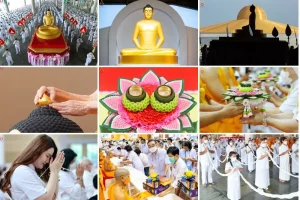An article by Andreas Jansen
Buddhism has been a force for good on this planet for an incredible 2,500 years.
Millions of people have found peace and prosperity through the ages under Buddhism, which has been sustained by possibly the oldest continuous organization the world has ever known, the Buddhist monkhood, or Sangha. Though the sangha has colorfully adapted to various cultures and languages as it peacefully spread through the world, all branches stay true to the core teachings of the Buddha, the awakened one. How did it all begin?
Rewind the clock back over 2500 years ago. The Buddha serenely sits alone under a bodhi tree, after having attained enlightenment. It took a marathon meditation session through the culmination of his life’s effort in reflection and meditation. He felt completely and permanently contented and unmoved to any worries or problems in the world. But then he wondered about the plight of all the other people around him, stuck in their habits and destined to suffer over and over again. Was it possible for others to also become enlightened and enjoy true inner peace? In his compassion, he decided to teach.
He sought out a group of five ascetics, a group of austere meditators whom the Buddha once trained with, because these were the people most ready to listen and understand. What did he teach?
- The Middle Way. To not indulge the senses nor torture oneself and instead live in the middle way, which leads to calmness, enlightenment and the permanent end of suffering.
- The Noble Eightfold Path. It defines the middle way into eight practiceable ways of living
- The four noble truths. One, the nature of sufferring common to all people. Two, the cause of suffering is attatchment.
Three, that suffering can be eliminated completely. Four, the way to eliminate sufferring is the noble eightfold path.
The five ascetics became the first sangha. As there was no written communication at the time, the sermon was memorised as a chant. This chant still exists today in the pali language and has been translated clearly into English. All Buddhists and Dhamma learners would do well to listen, chant, and penetrate it’s meaning as the Buddha intended. This first teaching was to be known as ‘The turning of the wheel of dhamma sermon’. Let’s keep the wheel of dhamma rolling on in our hearts and minds until we all reach the utmost happiness.
Dhammakaya temple welcomes the public to join in Dhammajak chanting
Recently at Dhammakaya temple, a Dhammajak chanting event started for the purpose of paying homage to to the large Buddha-image and the 1,000,000 smaller golden statues covering the Dhammakaya Cetiya in the middle of the Grand Meditation Stadium. The chanting has also become a tribute to Thailand’s monarch King Bhumibol who has just passed away. Monks, staff, and temple-goers started chanting at all times of the day to create a continuous hub of positivity, and figuratively spinning the ‘wheel of Dhamma’.
The initial goal was to reach 1,000,000 chants, which seemed almost impossible at first. But within two months the number of chants has surpassed that initial goal and the Dhammakaya Cetiya now sees almost 100,000 chants per day! As the number of chants rises further into the millions, consistency and remains key: people chanting in groups around the clock to remember the essence and importance of the Buddha’s teachings that started 2,500 years ago.
All visitors are welcome to join a session of Dhammajak chanting at Dhammakaya temple, Pathum Thani. Dhammajak chanting takes about 17 minutes and can be repeated as many times as you wish. To join you may contact an information desk at the Dhammakaya headquarter. Groups are very welcome.












